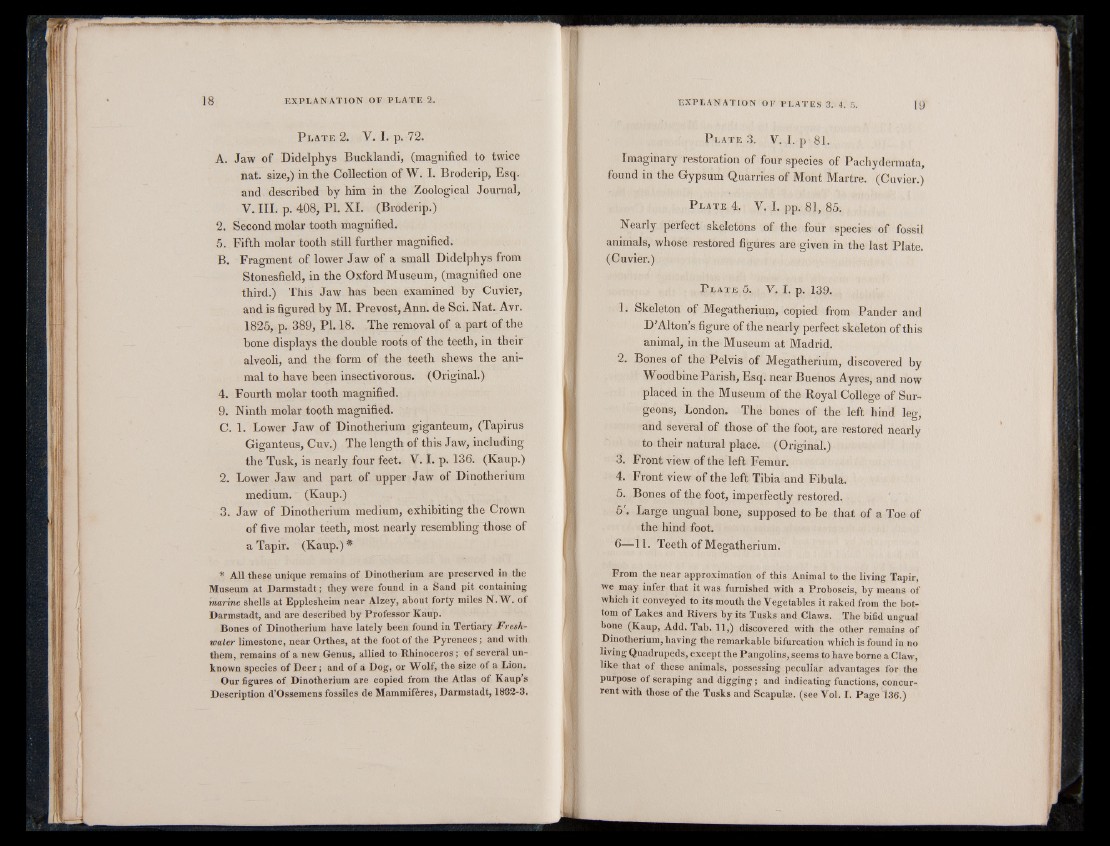
P late 2. V. I. p. 72.
A. Jaw of Didelphys Bucklandi, (magnified to twice
nat. size,) in the Collection of W. I. Broderip, Esq.
and described by him in the Zoological Journal,
V. III. p. 408, PI. XI. (Broderip.)
2. Second molar tooth magnified.
5. Fifth molar tooth still further magnified.
B. Fragment of lower Jaw of a small Didelphys from
Stonesfield, in the Oxford Museum, (magnified one
third.) This Jaw has been examined by Cuvier,
and is figured by M. Prévost, Ann. de Sci. Nat. Avr.
1825, p. 389, PI. 18. The removal of a part of the
bone displays the double roots of the teeth, in their
alveoli, and the form of the teeth shews the animal
to have been insectivorous. (Original.)
4. Fourth molar tooth magnified.
9. Ninth molar tooth magnified.
C. 1. Lower Jaw of Dinothérium giganteum, (Tapirus
Giganteus, Cuv.) The length of this Jaw, including
the Tusk, is nearly four feet. V. I. p. 136. (Kaup.)
2. Lower Jaw and part of upper Jaw of Dinothérium
medium. (Kaup.)
3. Jaw of Dinothérium medium, exhibiting the Crown
of five molar teeth, most nearly resembling those of
a Tapir. (Kaup.) *
* All these unique remains of Dinothérium are preserved in the
Museum at Darmstadt ; they were found in a Sand pit containing
marine shells at Epplesheim near Alzey, about forty miles N. W. of
Darmstadt, and are described by Professor Kaup.
Bones of Dinothérium have lately been found in Tertiary Freshwater
limestone, near Orthes, at the foot of the Pyrenees; and with
them, remains of a new Genus, allied to Rhinoceros ; of several unknown
species of Deer ; and of a Dog, or Wolf, the size of a Lion.
Our figures of Dinothérium are copied from the Atlas of Kaup’s
Description d’Ossemens fossiles de Mammifères, Darmstadt, 1882-3.
P late 3. V. I. p 81.
Imaginary restoration of four species of Pachydermata,
found in the Gypsum Quarries of Mont Martre. (Cuvier.)
P late 4. V. I. pp. 81, 85.
Nearly perfect skeletons of the four species of fossil
animals, whose restored figures are given in the last Plate.
(Cuvier.)
P late 5. V. I. p. 139.
1. Skeleton of Megatherium, copied from Pander and
D’Alton’s figure of the nearly perfect skeleton of this
animal, in the Museum at Madrid.
2. Bones of the Pelvis of Megatherium, discovered by
Woodbine Parish, Esq. near Buenos Ayres, and now
placed in the Museum of the Royal College of Surgeons,
London. The bones of the left hind leg,
and several of those of the foot, are restored nearly
to their natural place. (Original.)
3. Front view of the left Femur.
4. Front view of the left Tibia and Fibula.
5. Bones of the foot, imperfectly restored.
5'. Large ungual bone, supposed to be that of a Toe of
the hind foot.
6—11. Teeth of Megatherium.
From the near approximation of this Animal to the living Tapir,
we may infer that it was furnished with a Proboscis, by means of
which it conveyed to its mouth the Vegetables it raked from the bottom
of Lakes and Rivers by its Tusks and Claws. The bifid ungual
hone (Kaup, Add. Tab. 11,) discovered with the other remains of
Dinotherium, having the remarkable bifurcation which is found in no
living Quadrupeds, except the Pangolins, seems to have borne a Claw,
like that of these animals, possessing peculiar advantages for the
purpose of scraping and digging ; and indicating functions, concurrent
with those of the Tusks and Scapulas, (see Vol. I. Page 136.)